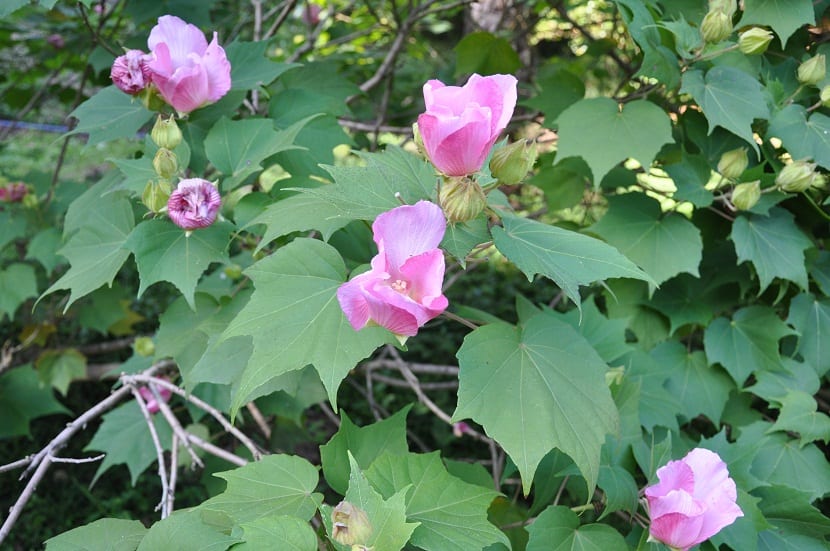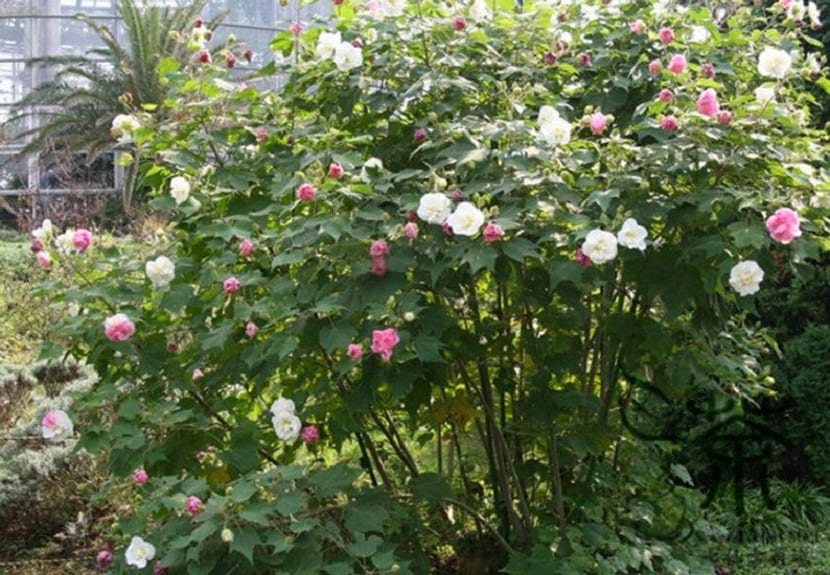
El Hibiscus mutabilis it is a perennial species belonging to the Malvaceae family. It is easy to grow, both inside the house and in the garden. Beautiful for its pleasant combination of colors that make the environment more cheerful and colorful. Its large green leaves recreate a tropical effect that is enhanced during flowering. Its small green globes are replaced by docile white flowers, which turn bright pink during the day.
Characteristics of the Hibiscus mutabilis

This shrub native to China, it is a small tree that can reach up to 5 meters in height with lax branches. Its leaves fall during winter, its thin stems are lost among neighboring plants until summer, when it takes on the appearance of a large thick mass. It has quite large leaves that can measure from 12 to 17 centimeters, of attractive bright green color, hairy at the bottom and rounded, with a margin of toothed leaves.
Its elegant maple leaves give the plant a distinguished mood. With double or single flowers, at the end of the summer and during the fall, its flowering becomes very intense. Its large, white flowers open and change their color to a deep pink over a period of about 3 days, when they die they show a rather dark pinkish-blue appearance.
A peculiarity of this plant is the fact that it can simultaneously display flowers of up to three different colors, due to the fact that the color cycle occurs independently of each other. Hence, the name mutabilis which means changing or variable. After flowering, its flowers give way to capsule-like fruits that release the seeds.
Cultivation and propagation
This species prefers soils rich in nutrients, well drained, humid and sunny. Nevertheless, it is a plant that can adapt very well to most soilsas long as they have good drainage. Although in its natural habitat it lives in full sun, its blooms can occur under partial shade. It does require regular watering, however, and if the soil is good it can tolerate droughts.
It can be propagated very well with the cuttings of its stems, it does not matter that these are hard and woody, they will still take root easily in moist soil. Once roots and cuttings are ready they are planted in the open the following spring.
Uses
This plant is prized for its large leaves and attractive multicolored flowers, which make it an appropriate species for both gardens and interiors, where its color and leafiness gives a beautiful and tropical look to the spaces. It can also be seen scattered in the landscapes. In China the Hibiscus mutabilis it is widely used in traditional medicine. Where its flowers and leaves are used as expectorants, analgesics, and antidotes to poison, they are equally applied to inflammations and skin infections.
Diseases and pests

El Hibiscus mutabilis it is the target of attacks by some insects and diseases. Some of the damages that parasites can cause to the Hibiscus are premature fall of the flowers, lack of flowering, holes in the leaves and petals of the plant, appearance of a viscous substance on the plants and on nearby surfaces (honeydew). The most common pests that can be observed in a hibiscus are the aphids, mites, thrips, scale insects and whiteflies.
Definitely the best way to avoid and combat these pesky insects is prevention. For this reason, in addition to irrigation or fertilization, it is important to check the plants periodically, so that if any type of harmful pest is observed, they can be eliminated quickly, thus preventing it from spreading and becoming difficult to eliminate, resulting in the death of the plant.
Specific pesticides should be applied only in case of specific massive pests. However, use natural pesticides whenever possible. Hibiscus is prone to leaf disease, such as those caused by trises molds (botrytis), downy mildew and powdery mildew. Symptoms can be white, gray, or yellow spots on the leaves, which can cause the leaves to dry out and fall off before flowering time.